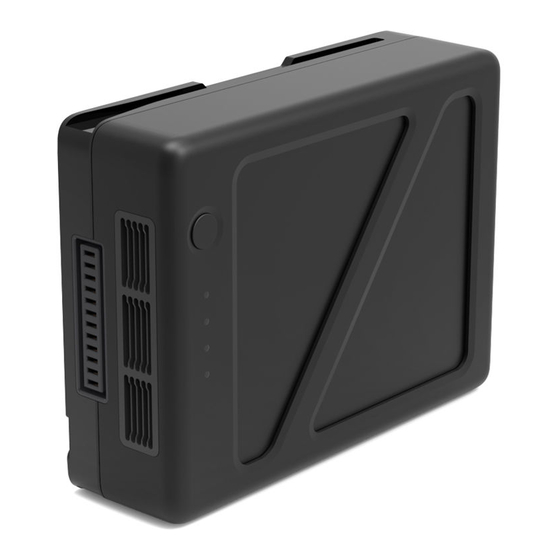Advertisement
Table of Contents
TB50 & TB55 User Guideline
Background
DJI released a firmware update on 16 November 2018 following reports of a small number of TB50 and TB55
batteries showing incorrect power levels which led to the loss of power mid-flight. The firmware update
addresses a rare issue involving the battery state of charge (SOC) calculation algorithm by incorporating the
following conservative measures listed below which serve to enhance the battery management system and
optimize power supply during flight.
On 19 December 2018, DJI released new firmware updates which serve to address a small number of reports of
Matrice 200 Series drone users experiencing early Return-to-Home (RTH) or Automatic Landing (AL). These
cases were the result of false alarms triggered by the conservative measures DJI implemented in November.
This new firmware update (v01.02.0301) further improves the algorithm accuracy of the battery management
system to enhance user experience without compromising flight safety and product reliability which remain DJI's
top priorities.
For TB55 batteries used with M200 series drones, the firmware update will impose these new battery
safeguards:
Additional battery heating before take-off (S1)
The additional heating will prevent batteries from turning off unexpectedly at low temperatures. The temperature
of both batteries must now be 16°C (61°F) or higher before the aircraft can take off. This is because a battery
with low temperature has a higher internal resistance, which causes lower voltage than in warmer conditions. A
battery with low voltage will provide a lower level of power to the drone, and hence impose higher risk of a power
1
loss.
Improved battery percentage and fault detection (S2)
The battery percentage check before take-off has been improved, and users will be warned when the battery is
faulty or the remaining battery charge suddenly jumps to a false higher percentage. The voltage of the battery
will be used to verify the SOC value by the further improved DJI algorithm in the new firmware. This SOC value
will be compared to the one calculated by the battery SOC calculation algorithm to determine if there is a "false
high" SOC reading. If there is a "false high" SOC reading, then the aircraft will not be able to take off.
Enhanced Return-to-Home (RTH) or Automatic Landing (S3)
When the DJI algorithm detects a difference in SOC levels (this calculation runs within the battery and is
therefore not visible to users through the screen) between the algorithm and the actual level that is too large,
RTH (Return-to-Home) will be activated at a detected battery level of 30% and Automatic Landing (AL) activated
at 10% (based on the DJI algorithm). Previously observed false alarms, that triggered early RTH or AL in a small
number of cases, have been reduced drastically.
For TB50 batteries used with M200 series drones, the FW update will impose this new battery safeguard:
Additional battery heating before take-off (S1)
The additional heating will prevent batteries from turning off unexpectedly at low temperatures. The temperature
of both batteries must be 16°C (61°F) or higher before the aircraft can take off. This is because a battery with
low temperature has a higher internal resistance, which causes lower voltage than in warmer conditions. A
battery with low voltage will provide a lower level of power to the drone, and hence impose higher risk of a power
2
loss.
1
Flight times vary depending on age of batteries, temperature of the environment, altitude or payload.
2
Flight times vary depending on age of batteries, temperature of the environment, altitude or payload.
(Updated – 19 December 2018)
Advertisement
Table of Contents

Summary of Contents for dji TB50
- Page 1 The voltage of the battery will be used to verify the SOC value by the further improved DJI algorithm in the new firmware. This SOC value will be compared to the one calculated by the battery SOC calculation algorithm to determine if there is a “false high”...
- Page 2 January. Battery is taking a longer time to heat up. This is caused by S1. DJI suggests pilots pre-heat their batteries or keep them at room temperature (about 16°C/61°F) before flying outdoors to minimize the risk of flight disruption.
- Page 3 TB50 & TB55 User Guideline (Updated – 19 December 2018) During flight Remember that flight times will be reduced when operating in cold environments. Make sure there is sufficient battery capacity to allow for a Return-to-Home. This also applies to the remote controller as it could power down during the flight if battery levels are not monitored.
















Need help?
Do you have a question about the TB50 and is the answer not in the manual?
Questions and answers